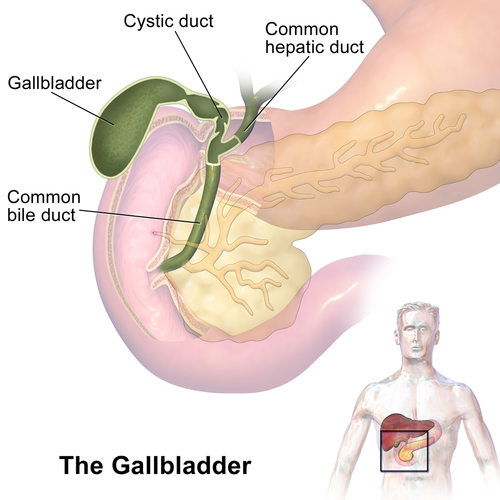Biliary tract
(Redirected from Bile ducts)
The biliary tract's main purpose is to transport bile from the liver to the duodenum. Bile is a fluid of yellowish-brown colour which consists of bile salts, bile pigments (bilirubin, biliverdin), fatty acids, lipids, cholesterol etc. It partakes in the emulsification of fats. Around 0,5-0,7 l of bile is produced per day.
The biliary tract can be divided by the localisation into intrahepatic (inside of the liver) and extrahepatic (outside of the liver) bile ducts.
Intrahepatic bile ducts[edit | edit source]
Intrahepatic bile ducts start in the liver as bile capillaries (bile canaliculi) between hepatocytes. They are thin and they are lined just by hepatocytes. The diameter of intrahepatic bile ducts is approx. 1-2 µm. Bile flows from the centre of the liver lobule to the periphery (portobiliary space) where intrahepatic bile ductules (canals of Hering) are formed. Canals of Hering are lined by low cuboidal epithelium. Those cells contain only a low number of organelles. They connect to interlobular bile ducts which are located in the portobiliary space as a part of the portal triad (as well as portal vein and interlobular artery). Portobiliary spaced is lined by three hepatic lobules. Interlobular bile ducts are lined by cuboidal epithelium supported by a basal lamina. They connect into segmental bile ducts which then form right and left hepatic ducts (ductus hepaticus dexter et sinister). Right and left hepatic ducts exit the liver at the porta hepatis (together with v. portae and a. hepatica propria).
Extrahepatic bile ducts[edit | edit source]
Extrahepatic bile ducts connect to intrahepatic bile ducts at the porta hepatis. They start as the right hepatic duct (made from the anterior and posterior ramus) and the left hepatic duct (made from medial and lateral ramus). They are lined by simple columnar epithelium. Right and left bile ducts then merge to create the common bile duct which is about 3-5 cm long and which enters the hepatoduodenal ligament (together with a hepatic proper artery on the left and portal vein in the back). Hepatoduodenal ligament is a part of lesser omentum and it makes the anterior margin of omental bursa - omental foramen. The common bile duct connects with the cystic duct (2-3 cm long) from the gallblader in the hepatoduodenal ligament and together they create the common bile duct. The length of the common bile duct is approx. 6-9 cm.
The common bile duct can be divided into 4 parts according to its position in the hepatoduodenal ligament:
- pars supraduodenalis - located above duodenum;
- pars retroduodenalis - crossing behind the superior duodenal flexure
- pars pancreatica - located behind the head of the pancreas
- pars intramuralis - part inside the wall of the duodenum; the common bile duct and the pancreatic duct come together here and open into the duodenum as major duodenal papilla (Vateri)
The common mouth of the ductus choledochus and the ductus pancreaticus on the papilla duodeni major occurs in 77 % of cases, in other cases it is separate. The ductus choledochus raises a fold during its course - plica longitudinalis duodeni. It is located in the pars descendens duodeni, on the posterior wall medially. In the middle of the fold is an elevated place - the papilla duodeni major. There is a cavity inside the papilla - the hepatopancreatic ampulla - which is the junction of the bile and pancreatic ducts. It is created in 50 % of cases. The connection takes place before the actual outlet on the papilla. The ampulla is closed by a sphincter - m. sphincter ampullae hepatopancreaticae. Also around the ductus choledochus and ductus pancreaticus, there is a sphincter - m. sphincter ductus choledochi (so-called Oddi's sphincter) and m. sphincter ductus pancreatici. The sphincters are contracted if there is no content in the gut. After eating, the m. sphincter ductus choledochi opens and releases bile while the m. sphincter ductus pancreatici remains contracted. It is a form of protection against the reflux of the bile into the pancreas. Bile activates pancreatic enzymes. If bile enters the pancreas, severe damage to the pancreas would follow, i.e. acute pancreatic necrosis.
Around 2 centimetres in cranial direction to the major duodenal papilla the accessory pancreatic duct opens into the duodenum as the minor duodenal papilla (Santorini)
Extrahepatic bile ducts are lined by simple columnar epithelium with microvilli. Nuclei are located in the base of the cell and there are mucin granules in the apical part of the cell. Lamina propria mucosae consist of loose connective tissue. Under Lamina propria mucosae smooth muscle cells are located. Smooth muscle cells form sphincters along the end of the common bile duct, pancreatic duct and hepatopancreatic ampulla.
Gallbladder[edit | edit source]
The gallbladder (vesica fellea, vesica biliaris) is located beneath the liver in fossa vesicae biliaris. The surface of the gallbladder that is not in contact with the liver is covered by the peritoneum which comes from the visceral surface of the liver.
The tunica mucosa of the gallbladder is lined by simple columnar epithelium with lamina propria mucosae made of loose connective tissue. The tunica mucosa forms fold distributed evenly over the lumen of the gallbladder. Those folds are visible the most on an empty gallbladder. The tunica muscularis is thin and its smooth muscle cells are oriented circularly. On top of the muscular layer, there is the tunica serosa.
The main function of the gallbladder is to store bile produced in the liver and to concentrate it before it is released into the duodenum.
Links[edit | edit source]
Related articled[edit | edit source]
- Liver
- Portal:Atlas of histology/Digestive tract
- Diagnostic imaging methods of the gallbladder and biliary tract
- Operations of the gallbladder and biliary tract
- Inflammatory diseases of the gallbladder and biliary tract
- Cholelithiasis
- Summery of gastrointestinal hormones
Used literature[edit | edit source]
- ČIHÁK, Radomír. Anatomie II. 2.. edition. Praha : Grada, 2001. pp. 488. ISBN 80-247-0143-X.

